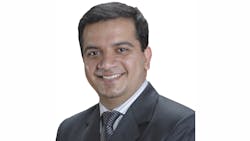Top 40 Under 40: Kashyap Bhimjiani
Kashyap Bhimjiani:
Drawn to the complexity of design in aviation projects
Kashyap Bhimjiani is known in aviation circles as Gensler’s design voice behind its Indian projects in Chennai and in Goa, on the company’s Mopa and Dabolim projects there. His also know for his work for JetBlue, American Airlines and British Air at JFK International Airport. As senior designer and associate, Bhimjiani brings a strong balance of design and an interest in maximizing the passenger experience and operational efficiency to terminal projects. Bhimjiani worked with local firms in Chennai to investigate the optimum gate layout and footprint and was able to insert the new domestic terminal into a constrained site that was bounded by a 400-year-old temple. For the Aerospace City master plan for Qatar, he organized a major runway and airspace demand models, assess to the site for the required university component, and resolved other environment issues to a successful conclusion. Is work at Tocumen Airport in Panama made efficient use of materials to create maximum impact on a modest space. Bhimjiani says he has always been intrigued by large scale projects that have a direct impact on the urban population. He says, “Airports provide one of the most complex combination of all building types at an urban scale such as transit, retail, hospitality, lifestyle, etc. It requires a thorough understanding of functional as well as formal relationships.”
Kashyap Bhimjiani
Senior Designer & Associate
Gensler
Age:
Years in Aviation:
Did you know?
Dabbles in architectural photography.
1) Why did you select aviation as a career?
As an architectural designer, I have always been intrigued by large scale projects that have a direct impact on the urban population. This led me to explore a deeper understanding of transit environments, particularly airports. Airports provide one of the most complex combination of all building types at an urban scale such as transit, retail, hospitality, lifestyle, etc. It requires a thorough understanding of functional as well as formal relationships. The complexity of design challenges and the opportunities presented along with it have prompted me to develop my expertise in aviation.
2) What advice from a mentor helped you the most in your career?
One of the most important advice that I received from my mentor is to recognize the nuances between aspirations(want) and requirements(need) of clients for aviation projects. While working on projects around the world, I quickly realized how important it is to understand these cultural differences and ensure that the responses are tailored to each project to create a unique design solution.
3) What is the biggest challenge you see facing aviation today?
More people are travelling today than ever before due to rapid globalization. As a result, airports have become the first place of interface that provides an introduction to a country or a city. At the same time, security and ease of travel is becoming increasingly important. To provide a sense of place and create an enhanced passenger experience while maintaining a flexible, functional and secure environment is one of the biggest challenges facing aviation today.
4) What advice would you give to others in the industry?
Aviation is a multi-disciplinary industry. As planners, designers and stakeholders, we need to continue to collaborate closely with each other to generate exemplary solutions and rejuvenate the early notion of celebrating travel. We need to recognize that airports are no longer merely about travel, it’s also about a place to shop, eat and relax. In essence, airports have become a integral part of our urban fabric, interwoven with our modern lifestyle.
5) What are three things we don’t know about you?
Three interesting things about me are:
- I am an urban traveler and like visiting cities around the world to augment my cultural IQ.
- I enjoy architectural photography and wait forever to get a picture devoid of any people in it.
- I used to play state level table-tennis (Ping-Pong) in my childhood.
